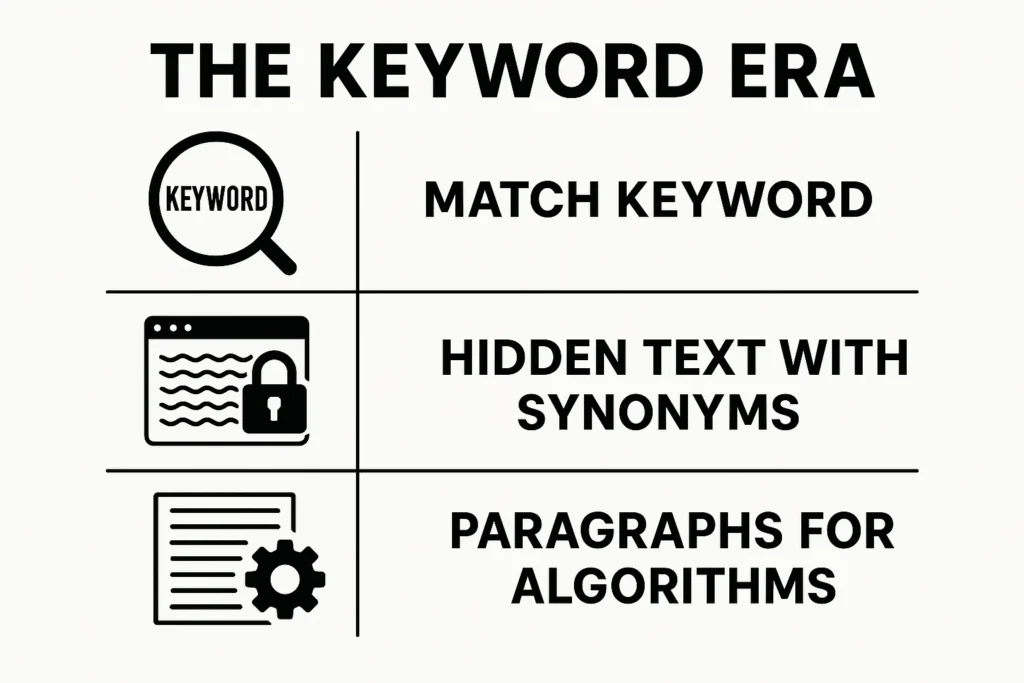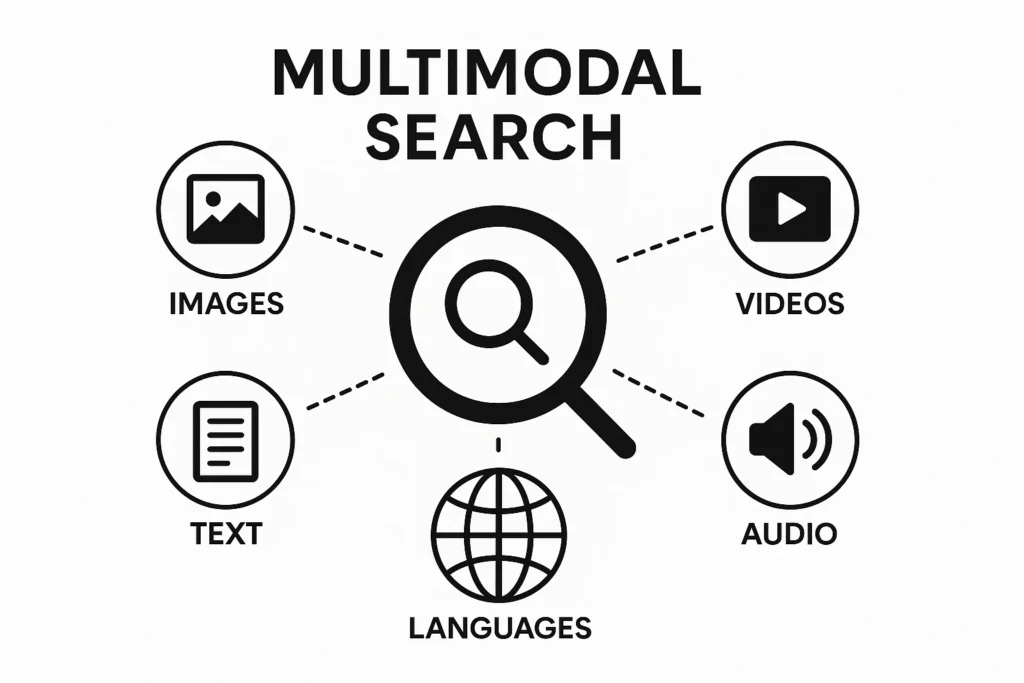Search used to be about typing the right words in the right order. Not anymore. Over the past two decades, information retrieval has gone from matching strings to understanding intent. What started as basic keyword lookup is now a layered, AI-powered process involving embeddings, transformers, and generative reasoning.
In this article, we’ll unpack how we got here and why the systems behind today’s search engines are doing a lot more than just finding documents.
The Early Days: Indexes, Tokens, and TF-IDF
Before search engines could “understand” anything, they had to keep it simple. Early systems, like Cornell’s SMART in the 1960s, used an architecture called an inverted index – essentially a fancy lookup table that told you where each word appeared.
The process went something like this:
- Break the documents into words (tokenization).
- Strip those words down to their roots (stemming).
- Store a list of which documents contain which words.
So if you searched for “running,” the system might look up “run” and show you all documents that included it. The engine wasn’t trying to understand what you meant by “running.” It was just matching characters.
TF-IDF: A First Attempt at Relevance
To make results more relevant, engineers turned to TF-IDF (Term Frequency-Inverse Document Frequency). It gave higher scores to words that showed up a lot in one document but not everywhere else. That helped elevate more unique and relevant content.
But here’s the catch – all of this was still string matching. The system didn’t know that “car” and “automobile” meant the same thing. If you didn’t use the right word, you could miss the right result.
And that led to a decade-long obsession with keywords.

The Keyword Era: Match or Miss
Once SEO became a thing, the entire discipline evolved around this simple limitation: search engines could only match what you gave them. So if you wanted to rank for “best laptop,” you had to put that exact phrase in your content. Maybe more than once.
This led to some familiar (and questionable) practices:
- Exact match keyword stuffing.
- Hidden text packed with synonyms.
- Paragraphs written for algorithms, not people.
It worked for a while. But it also broke the experience. Search results felt clunky. Pages gamed the system. And search engines knew it.
Something had to change, and it did.
Cracks in the System: LSI and the First Steps Toward Semantics
In the 1990s, researchers began exploring Latent Semantic Indexing (LSI). This tried to solve the synonym problem by mapping relationships between words and documents mathematically.
The idea was: if “car” and “automobile” often appear in similar contexts, maybe the system could infer their similarity.
In theory, LSI was promising. But it was:
- Slow.
- Sensitive to noisy data.
- Not easily updated.
Ultimately, it was a clever patch, not a true breakthrough.
Real progress came when search engines stopped treating words as symbols and started treating them as points in space.
A New Language: Embeddings and Vector Search
The breakthrough came with a deceptively simple idea: “You shall know a word by the company it keeps.”
That quote, from British linguist J.R. Firth was the seed of a revolution. Instead of just looking at words, what if we represented them as vectors – points in a multi-dimensional space – based on the words that often appear around them?
Word2Vec Changed Everything
In 2013, Google introduced Word2Vec. It didn’t just understand that “king” and “queen” were related – it could infer relationships like this:
vector(“king”) – vector(“man”) + vector(“woman”) ≈ vector(“queen”)
This wasn’t programmed in. It emerged naturally from training on massive amounts of text.
Now, search engines had a way to measure meaning. They could:
- Find synonyms dynamically.
- Understand analogies.
- Expand queries without human-made thesauruses.
From Words to Sentences and Documents
Other models followed:
- GloVe (from Stanford) captured global co-occurrence statistics.
- FastText (from Facebook) improved handling of rare words and typos.
- Doc2Vec, Universal Sentence Encoder, and Sentence-BERT allowed embedding of entire sentences or documents.
And suddenly, we weren’t searching for words anymore. We were searching for meaning.
Neural Ranking: Relevance Gets Smarter
Embedding-based search made things better, but also harder to scale. You couldn’t throw away everything that worked with inverted indexes.
So the major search engines adopted a hybrid strategy:
- Use traditional lexical methods (like BM25) to pull the top 1,000 results.
- Re-rank them using embeddings and semantic similarity.
This meant your content could be retrieved even if the query didn’t include your exact keywords, as long as the intent matched.
From a content perspective, this was a huge shift. It meant:
- Relevance was based on meaning, not just phrase match.
- Good writing and clear explanations could win over awkward keyword stuffing.
Then Came the Transformers
Even embeddings had their limits. Word2Vec, GloVe, and friends used fixed vectors – the word “bank” had the same vector whether you meant “river bank” or “bank account.”
Transformers fixed that.
Introduced in 2017 by Vaswani et al., the transformer architecture used self-attention to understand which words in a sentence mattered most – in both directions. Every word had a unique representation based on its context.
Then came BERT.
BERT (Bidirectional Encoder Representations from Transformers) let Google understand the full context of a search query.
So, if you searched: “Can you get medicine for someone at the pharmacy?”, BERT could understand that “for someone” changed the meaning entirely. Pre-BERT, Google might have missed that nuance.
It also helped with:
- Passage-based retrieval.
- Snippet highlighting.
- Intent clarity in long queries.
BERT wasn’t the end of the road, but it set a new baseline.
From Retrieval to Generation: Enter the LLMs
While BERT was improving how engines understood your queries, another stream of innovation was reshaping what engines could do with the results.
Generative models, like the GPT family, weren’t just designed to retrieve information. They were built to produce it.
Retrieval-Augmented Generation (RAG) is the model behind many current AI systems:
- First, retrieve relevant documents using dense search.
- Then, generate a fluent, context-aware answer using a large language model.
It’s not just about finding the right document anymore. It’s about blending facts from multiple sources and presenting them conversationally.
What does this mean for content creators?
- Your content might be used, cited, or paraphrased, even if you’re never linked.
- You need to show up in the retrieval phase, or the model won’t use you in generation.

Multimodal Search: Beyond Text
Another major shift is happening, and it’s about more than words.
Google’s MUM (Multitask Unified Model) is trained across:
- Text.
- Images.
- Videos.
- Audio.
- Languages.
Which means:
- You can take a picture of hiking boots and ask if they’re good for Mount Fuji in October.
- The system might retrieve YouTube videos, blogs, product pages, and trail maps — and understand them all.
This changes the game for search:
- Alt text and transcripts matter more than ever.
- Structured data helps machines understand what your content is, not just what it says.
- Language barriers are starting to disappear.
Efficient Retrieval at Scale: Muvera and the Next Leap
As semantic search got smarter, it also got heavier. Embedding every document, comparing every query – that takes serious compute.
Muvera, a recent advancement, solves this with Fixed-Dimensional Encodings (FDEs). These let systems:
- Compress multi-vector models into single, fast-to-query vectors.
- Preserve ranking quality.
- Reduce latency and server load.
For users, this just means faster and better results. For search engineers, it’s a more scalable architecture. For businesses, it’s one more reason to optimize for meaning, not just match.
The New Playbook for Information Visibility
If you’ve skimmed down to this point, here’s the big picture: we’ve gone from string matching to meaning matching, and now we’re entering a phase where content is selectively synthesized into generative answers.
To stay visible in this new IR landscape:
- Write for users, not keywords: clarity and usefulness win.
- Structure your content semantically: use headings, schema markup, and context.
- Cover topics deeply: topical authority now influences domain embeddings.
- Think beyond articles: alt text, video captions, podcast summaries all matter.
- Monitor AI Overviews and generative outputs: if you’re not showing up there, you’re missing the conversation.

Where Nuoptima Fits in the New Search Era
At Nuoptima, we’ve seen firsthand how the rules of search have changed. The days of chasing keyword density are long gone. What matters now is context, intent, and structure. That’s why we focus on building relevance, not just rankings. We don’t just help brands show up in search – we help them show up where it counts: in the answers that AI systems are generating right now.
As information retrieval shifts toward semantic understanding, vector-based search, and multimodal inputs, our work evolves with it. We combine technical SEO, link-building, and content strategy with a sharp eye on how engines like ChatGPT, Gemini, and Perplexity are pulling and synthesizing content. GEO isn’t a buzzword to us – it’s baked into how we build visibility. We map out how search engines interpret your domain, your authors, and your topical clusters, then optimize from there.
The bottom line? We help businesses speak the new language of search. Whether that means rewriting category pages to align with vector neighborhoods or crafting long-form content that survives the AI summarization chop, we stay focused on one thing: making sure your message lands where decisions are being made.
Final Thoughts: Search Isn’t Search Anymore
What we call “search” has evolved into something much bigger. It’s not just a lookup tool. It’s a reasoning engine. A conversation partner. A synthesizer of sources.
Search engines today aren’t just trying to find what you typed. They’re trying to understand what you meant, what’s relevant, and how to deliver it in a form you’ll actually engage with.
For content creators, SEOs, and marketers, that’s both a challenge and an opportunity. Because now, visibility isn’t just about ranking.
It’s about being included in the answer.
FAQ
Because keyword matching hits a wall fast. It’s great when the user and the content use the same exact words, but that rarely happens. People phrase things in all sorts of ways, and synonyms, slang, or even typos can throw off a strict match system. The shift toward semantic search lets engines understand what users mean, not just what they type.
Embeddings are like map coordinates for meaning. Instead of treating words as isolated labels, search systems turn them into vectors – points in space – based on the words they appear near. So “jaguar” as a car lands somewhere totally different from “jaguar” the animal. This helps systems understand context and match queries to the right results, even when the words don’t literally match.
Definitely, but not in the old-school sense of stuffing exact phrases. Keywords now serve as signals, clues about user intent and topic clusters. The focus has shifted from “where do I repeat this word?” to “how do I build semantic depth around this concept?” It’s more about covering the topic well than checking off boxes.
BERT helps Google understand the meaning behind search queries, especially ones that are long, vague, or phrased like a question. MUM goes even further – it’s multimodal, meaning it can understand images and text together, and multilingual, meaning it pulls insights from content in any language. It’s all about narrowing the gap between what people ask and what they actually want to know.
Start by writing for people, not algorithms. That sounds obvious, but it’s surprisingly easy to fall into the trap of over-optimizing. Focus on clarity, structure, and depth. Use headers. Answer questions. Provide context. And think beyond the page – audio transcripts, alt text, and structured data all feed the machines now. You’re not just trying to rank. You’re trying to be included in an answer.



